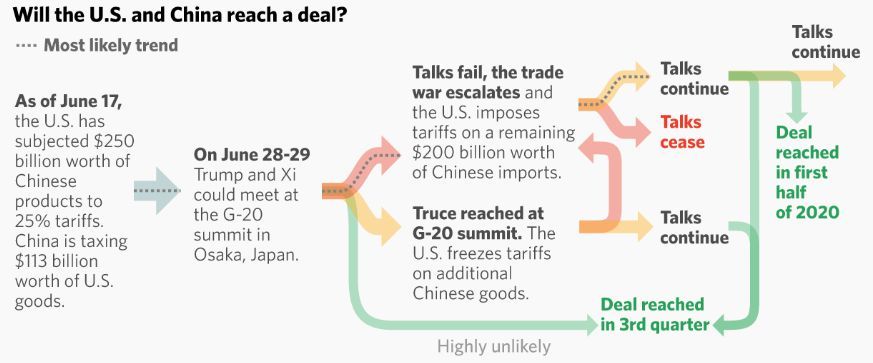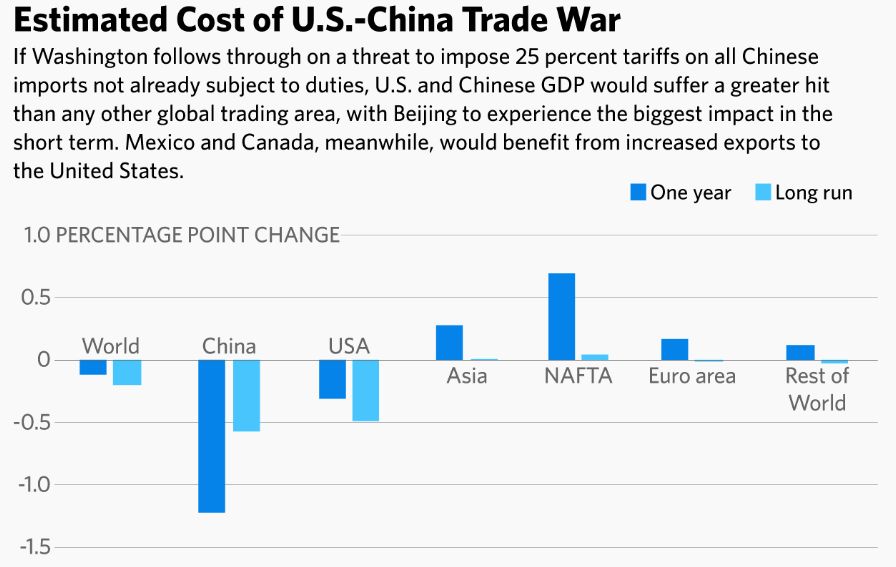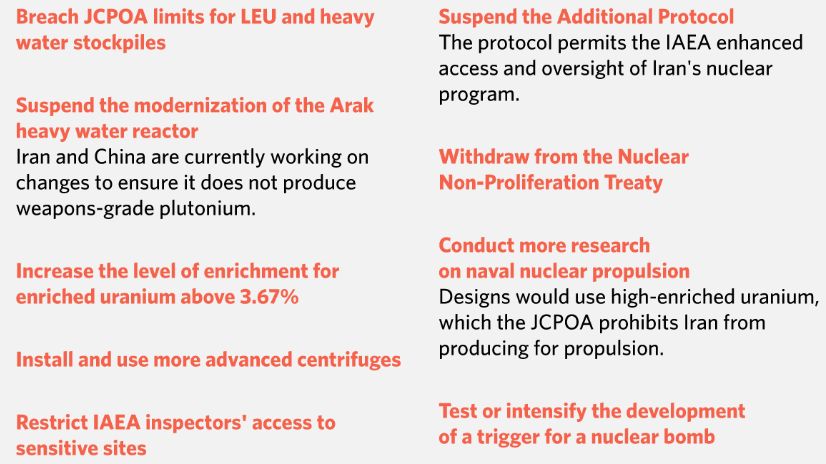By Eric Vandenbroeck and co-workers
The Trump Tariffs Wars
The
6 June issue of The Economist showed a telling image and commented that
America is deploying new tactics, poker-style brinkmanship, and new weapons
that exploit its role as the nerve centre of the global economy to block the
free flow of goods, data, ideas and money across borders. This pumped-up vision
of a 21st-century superpower may be seductive for some. But it could spark a
crisis, and it is eroding America’s most valuable asset, its legitimacy.
There is a small
window for a trade truce, but with a deliberate attempt by the White House to
cripple Chinese tech giant Huawei Technologies Co. the White House has
narrowed the middle ground. And for every U.S. action designed to coerce
Beijing into making greater concessions, there will be a Chinese reaction that
pushes the economic giants further apart in the negotiation. For example, U.S.
trade assaults on China will prompt Beijing to increase financial support for
strategic sectors, such as the semiconductor industry, directly violating a
U.S. demand to reduce state support and level the playing field for foreign
businesses. Chinese tariff retaliation and possible boycotts of U.S. goods will
counteract Washington's demand for China to buy more American products to
reduce the U.S. trade deficit. Chinese attempts to push back against the United
States by selectively blacklisting and fining American firms only feeds into a
familiar White House complaint: that China actively discriminates against
foreign businesses.
A potential Chinese
restriction of rare earth exports will amplify threats to U.S. commerce
that the White House is citing to legally justify Section 301 tariffs in the
first place. And the unavoidable depreciation of the yuan from the stress of
the trade war will be used by the White House to
name and shame China as a currency "manipulator" bent on
disadvantaging U.S. exporters. This burning economic dispute is meanwhile
unfolding against a backdrop of rising security tensions in the South China Sea
and growing pushback against Beijing in China's periphery, where the United
States has the potential to apply sanctions against the Chinese government and
its affiliates in the name of protecting human rights and democracy. This
geopolitical climate does not bode well for Trump and Chinese President Xi
Jinping to reach a breakthrough in negotiations if and when they meet at the G-20
summit in Japan in late June. For now, the most likely outcome from the meeting
between Chinese President Xi Jinping and US counterpart Donald Trump. Thus
Beijing will keep the door open for future dialogue, and Trump still has the
option of buying more time in the negotiation before resorting to
all-encompassing tariffs. But the window for a truce is closing fast, and Xi
and Trump will have enough political backing to prolong their economic war for
a number of months.

While Mexico has been
among the main beneficiaries of the U.S.-China trade war, Trump's tariff
threats against Mexico could resurface around 22 July and again on 5 Sept.,
when the Mexican government is supposed to deliver to the White House its
progress report on curbing illegal border crossings. Already on the edge of
recession, Mexico will be careful to avoid a confrontation with the White House
in an effort to steer clear of costly tariffs. After more than a quarter of a
century of tariff-free trade on the U.S.-Mexico border, the economic impact of
just 5 percent tariffs on Mexican imports, as Trump earlier threatened, would
be tantamount to ripping up the North American Free Trade Agreement and
returning to average World Trade Organization-level tariffs for most sectors.
Supply chain disruptions would reverberate across the auto, electronic,
industrial and food sectors. Furthermore, U.S. agricultural producers would be
singled out for retaliatory tariffs, and Congress could even regain momentum to
challenge the president's trade authority, though a veto-proof majority on such
a measure would be far from assured. Even if Trump avoids the heavy economic
and political toll that comes with disrupting North American trade through
tariffs, the uncertainty that comes with merely keeping the threat alive will
continue to erode investor confidence.
The threat of auto
tariffs will meanwhile continue to loom large as Trump waits for U.S. trading
partners to come to him with a "solution" by November, in the form of
voluntary export restraints and/or acceptance of U.S. quotas. While Japan has a
better chance of negotiating a trade compromise with the White House that
includes agriculture and autos, EU leaders, too divided and consumed with
horse-trading over political positions in the European Union for most of the
quarter, will resist the White House's ultimatum on restricting auto exports to
the United States. As a result, there won't be much movement in Continental
trade negotiations with the Trump administration. The psychological impact of
Trump's tariff weaponization strategy will linger for a fair amount of months.
The White House has
already raised the WTO's hackles by stretching the definition of national
security to justify a variety of tariffs, all while discrediting the global
trade body's authority to arbitrate trade disputes. With a Dec. 10 deadline
pending for the United States to lift its siege on the WTO Appellate Body or
else drive it into paralysis, European leaders will prepare for the worst and
work on convincing other WTO members to sign onto an ad hoc solution that would
have former WTO appeals judges settle trade disputes under WTO arbitration
rules until a compromise, likely with the next White House, can be found.
The European Union's
creative workaround at the WTO points to a growing assumption among U.S. allies
and adversaries alike that negotiation with the current White House may be
futile. Erratic U.S. negotiating tactics and the elusiveness of a final, negotiated
settlement will bruise business confidence and investor sentiment globally.
Hamfisted diplomacy will also convince a number of powers, including China,
Europe and Iran, that seeing out the result of the 2020 U.S. election makes
more strategic sense than entertaining heavy concessions in a negotiation with
the Trump White House over a deal that may or may not last.
Risk Bludgeons
In the face of yet
another major tariff escalation, China will erect stronger capital controls and
draw on its reserves to defend its currency, the yuan. China’s Central Bank
will intervene to avoid a steep and sudden devaluation because a depreciation beyond
7 yuan to the dollar will exacerbate China’s economic slowdown and place
greater stress on emerging market currencies. Heavy downside risk from the
White House’s trade wars will drive the U.S. Federal Reserve to ease interest
rates the coming months.
According to the IMF:

A variety of
competing factors will slow but not quite stall the global economy in the
coming months. The European Central Bank has already abandoned plans to tighten
monetary policy this year as crises of the European Union’s own making roil the
bloc. We do not think this quarter will end in a no-deal Brexit, but an
escalation of political chaos in the United Kingdom, along with a drawn-out
confrontation between Rome and Brussels over Italy’s expansive fiscal policies,
will continue to sap at European growth amid rising global trade frictions.
For energy markets,
between the opposing forces of slowing consumer demand and the threat of
military conflict in the Persian Gulf creating a sharp supply disruption, oil
prices will remain in flux. When the Organization of Petroleum Exporting
Countries meets early in the quarter (with its expanded retinue of
crude-producing partners, a collective known as OPEC+), Saudi Arabia and Russia
will drive an agreement to extend production cuts into the second half of the
year as the world’s biggest oil producers try to contend with rising U.S.
inventories and weaker global demand.
Great Power Competition Drives Global Tech
Fragmentation
If Xi and Trump agree
to de-escalate the trade war this quarter, the White House could offer a
selective and partial relaxation of export controls on goods and/or licenses
that fall outside of highly strategic applications, specifically, dual-use
technologies that could be used for security, surveillance or defense purposes.
Pressure from affected U.S. businesses and ongoing court challenges could also
have the effect of weakening U.S. restrictions against Huawei.
Regardless of their
country of origin, global tech companies
will find themselves on the firing line as the U.S.-China trade dispute
heats up. Uncertainty surrounding the U.S.-China trade negotiation and the viral
nature of U.S. export law, in which even a minimal amount of U.S. components,
software and technology could subject a company to sanctions, will accelerate
Chinese efforts to shore up indigenous semiconductor development. Huawei will
further seek to roll out an independent operating system for smartphones to
maintain the company's global market share. China will struggle to reduce its
reliance on major international chip providers, such as Intel Corp., Samsung
Electronics and the Taiwan Semiconductor Manufacturing Company (TSMC), that are
now liable for U.S. sanctions. But over time, the rise of Chinese competitors
in the chip manufacturing sector and the rollout of Chinese software
alternatives, such as Huawei's mobile operating system challenger to iOS and
Android, are likely to contribute further to the fragmentation of the global
tech sector. Ongoing U.S. diplomatic efforts to pressure countries in Europe,
Latin America and Southeast Asia into imposing similar bans against Huawei
equipment on national security grounds are already stalling. This is because
most countries are unwilling to tolerate the much higher costs and
implementation delays for 5G networks that would come with blacklisting Huawei.
But the broad reach of U.S. export controls against Huawei will now give many
of these governments and relevant telecommunications partners pause as they
weigh a much bigger compliance risk in dealing with the Chinese firm.
Even as its efforts
to defang Chinese tech leaders gain momentum, the U.S. government has also made
a point of targeting the exact Silicon Valley tech giants that Washington
relies on to outperform China in a global race for technological supremacy. In
line with Stratfor's 2019 Annual Forecast, bipartisan momentum is quickening
behind U.S. efforts to scrutinize Big Tech over antitrust, privacy and free
speech concerns. Google and Facebook are likely at the top of the list for the
Federal Trade Commission and the Justice Department, which share oversight
duties over the United States' largest tech firms. U.S. tech companies will
also remain a prominent target in the European Union, where Ireland has
launched a probe into Google for violating the European Union's General Data
Protection Regulation on privacy protections.
Iran
The Trump White House
is operating under an assumption that its ability to choke off Iranian exports
and inflict heavy economic pain on the Islamic Republic will drive Tehran to
the negotiating table or, better yet, instigate a grassroots overthrow of the
clerical regime. Neither is likely to happen, though, and certainly not this
quarter. At most, Tehran could rely on third-party mediators to establish a
deconfliction channel with the United States as military frictions rise. Trump
appears well aware of the political flack he would receive by committing the
United States to yet another massive military conflict in the Middle East and
so is likely to exercise some restraint in trying to avoid a costly military
scenario with Iran. But there are a number of triggers that will arise this
quarter, such as Iran telegraphing threats to shipping in the Persian Gulf and
restarting parts of its nuclear program, that will embolden White House hawks
to argue for punitive strikes against Iran.
Potential next steps of Iran

A lingering threat of
military confrontation between the United States and Iran will detract from
Washington's focus on its burgeoning great power competition with both China
and Russia. Beyond high-stakes economic battles, the potential for skirmishes between
the United States and China in the South China Sea and in the Taiwan Strait
will rise as the U.S. Navy and Coast Guard steadily expand their footprint in
China's near abroad. Russia, meanwhile, will oscillate between instigator and
mediator in multiple theaters that have the potential to dominate the White
House's attention. While Russia already provides significant political and
economic backing to Iran and Venezuela, it can always dial up military support
should it see an opportunity to generate leverage against a highly distracted
White House. U.S. attempts to coax Russia and China into a trilateral strategic
arms control treaty are unlikely to gain much momentum this quarter as arms
buildups continue on all sides.
The way forward with Iran
The alternative to
today’s course is talks between America and Iran. Just now that looks
far-fetched. Iran’s foreign ministry says American sanctions imposed on
Ayatollah Ali Khamenei, the supreme leader, and other top officials this week
mark “the permanent closure of the path of diplomacy.” Rouhani has suggested
that the White House is “mentally handicapped,” after which Trump threatened
“obliteration.”
But optimists will
remember similar clashes between America’s president and Kim Jong Un, North
Korea’s despot before they met in Singapore and “fell in love”, as Trump put
it. When he is not threatening to annihilate the mullahs, Trump is offering to
talk without preconditions and to “make Iran great again”. He does not want the
prospect of war in the Middle East looming over his re-election campaign.
Likewise, in Iran the economy is shrinking, prices are rising and people are
becoming fed up. The pressure is growing on Khamenei to justify his
intransigence. Love could yet bloom.
America might coax
Iran back to the table with a gesture of good faith, such as reinstating
waivers that let some countries buy Iranian oil. Iran, in turn, could promise
to comply with the nuclear deal again. Behind the scenes, its leaders have
expressed a willingness to sign something like the old agreement with
additions, such as extending parts of the deal beyond 2030. Negotiations would
never be easy; the Iranians are infuriating to deal with. But that would let
the president claim victory, as he did with the United States-Mexico-Canada
Agreement, which his administration signed last year and which looks a lot like
its predecessor, the North American Free Trade Agreement.
What if a deal that
also curbs Iran’s missile program and restrains it in the region? As Trump
seems to realize, biting everything off in one go is unrealistic. A new deal
cannot solve all the problems posed by Iran or normalize ties with America
after decades of enmity. It may not even lift all America’s sanctions. Neither
did the first agreement. But, if done right, a deal would put Iran’s nuclear
program back in a box, making it easier to tackle all those other problems
without causing a war.
N.Korea and Venezuela
Unlike most countries
dealing with the current White House, North Korea is trying to accelerate
negotiations while Trump is still in office. Now that the United States has
little choice but to plan for a military contingency around Iran, Pyongyang
will have more room to push the line on missile testing while trying to break
through a stalemate in negotiations. North Korean leader Kim Jong Un remains
confident that Trump would rather keep North Korea in diplomatic limbo and call
it a foreign policy win than return to a military confrontation with Pyongyang.
When compared to a
prospective nuclear-equipped nation, Venezuela inevitably falls much lower on
the list of U.S. foreign policy priorities. Even as the persistent threat of
another coup attempt and the specter of greater Russian involvement in
Venezuela will vie for Washington’s attention, the White House is unlikely to
risk a messy military intervention at this stage to force regime change. A
steady intensification of U.S. sanctions and ongoing backchannel dialogue with
military leaders to try and crack the rule of President Nicolas Maduro will be
the White House’s preferred method of managing Venezuela as the country
descends further into chaos.
The Trade War with China going forward
Trump's
administration’s China policy reflects Trump’s belief that China has long taken
advantage of the United States, especially on trade. Whatever the merits of
that position, a response focused on changing China’s behavior is woefully
inadequate. U.S. primacy was born not by defensive protectionism but by
building the greatest economic engine in human history. Keeping ahead of China
is much more about the US than about China.
A good place for the
next president to start would be by reviving U.S. participation in the
Trans-Pacific Partnership. A stronger TPP with U.S. involvement would be the
ultimate tool for checking China’s unfair trade practices. It would signal to
Beijing that it can only shape Asia’s economic future by respecting
intellectual property, dismantling bloated state-owned enterprises, and playing
fairly with other countries. Trump’s decision to scrap the TPP, in 2017,
conveyed exactly the opposite message, assuring China’s leaders that they could
double down on the old ways of doing business without consequences.
For updates click homepage here